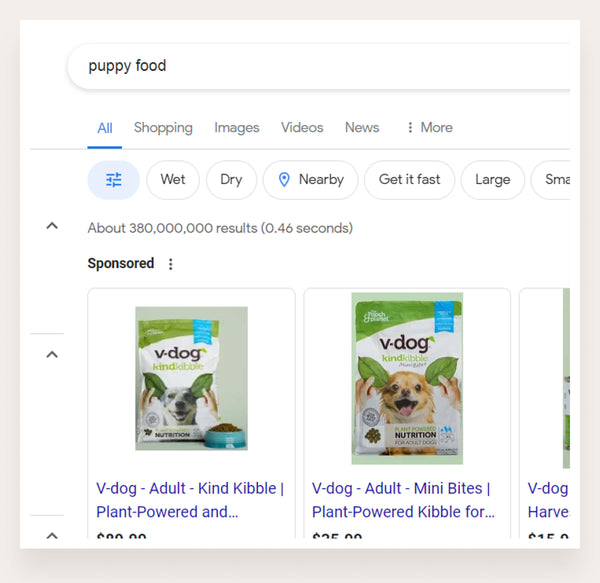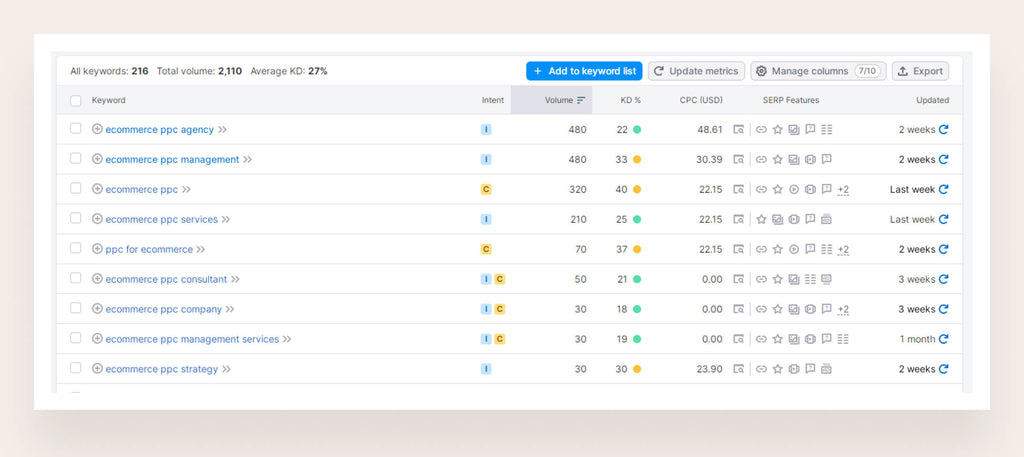Search Engine Optimization (SEO) and Pay-Per-Click (PPC) advertising are distinct yet complementary approaches to achieving brand visibility and fostering eCommerce sales in a crowded online marketplace. While SEO focuses on optimizing your website and content to rank organically, PPC advertising allows you to display targeted ads on search engine result pages, web pages, and eCommerce platforms like Amazon and eBay.
The two-pronged approach that combines eCommerce PPC strategies and SEO ensures continuity in sales targeting and lead generation. Read on to see how both help you attract more customers online.
How can eCommerce SEO strategies help attract better leads?
You can implement both on-page and off-page eCommerce SEO for better conversions and drive significant traffic (as much as 226%) back to your website. Here is how:
The role of on-page optimization
On-page eCommerce SEO optimizes the page content and structure of online stores to improve SERP ranking and user experience.
Keyword research and targeting
Keyword research allows you to find the best-performing search phrases and understand user intent- are they seeking information or are ready to purchase? With this knowledge, you can tailor your content to address specific customer needs, allowing for more precise targeting.
Optimizing page titles and meta descriptions
Search engines rely on these elements to understand your content and rank pages accordingly. Optimizing them with relevant keywords increases the likelihood of your website appearing higher in Search Engine Results Pages (SERPs).
Image optimization
Optimized images primarily improve website speed and visibility. By using relevant keywords in image titles and alt tags, you may appear at a higher position on image SERPs. This increases the chances of attracting potential customers who explore product images.
The role of off-page optimization
Off-page or off-site eCommerce SEO strategies cover all optimization techniques undertaken off of the website itself.
Link building strategies
Backlinks from multiple authoritative websites redirect users to your website, allowing you to engage visitors who didn’t initially land on your page. This expands your reach and helps generate more fresh leads. Further, with more high-authority backlinks, your website will have a higher chance of ranking in the SERPs.
Local SEO for brick-and-mortar stores
Local SEO ensures that your online business appears among search results when people look for similar products/ services near your physical store. This is done by optimizing for local keywords and phrases used by people in your area, setting up your GMB (Google My Business) account with accurate details, implementing local schema markup for better search snippets, and acquiring quality backlinks from other local businesses.
Reputation management and online reviews
Encourage and respond to customer reviews on your GMB listing and other platforms like Yelp and Amazon as part of your eCommerce SEO strategies. When you respond to user feedback, both positive and negative, it demonstrates your commitment to customer satisfaction and results in a credible reputation.
How can eCommerce PPC help attract more leads?
Setting up an effective PPC campaign
Get an idea of what you want to achieve with a PPC campaign, whether it’s increased website traffic, fresh leads, or more sales.
Keyword research and targeting
Identify relevant keywords with modestly high search volumes that people use to locate products and services like yours. You can use tools like Semrush and Google Keyword Planner. Once done, analyze the keywords to understand the user search intent and online behavior for better sales targeting.
Creating compelling ad copy
Clear, concise, and compelling ad copies highlight your USP (unique selling proposition) and guide people to your landing pages by including strategic CTAs like “Start a free trial,” “Learn more,” and “Buy now.” Experiment with different descriptions, headlines, and CTAs to see what your audience finds better.
Landing page optimization
Always keep conversions in mind. Ensure that the landing pages users reach after clicking your ad are readable, navigable, and straightforward. Optimize them for better clarity, use feedback widgets to get real-time opinions, and include trust indicators such as user ratings and testimonials.
By focusing on the right keywords, optimizing bidding strategies, and crafting compelling ad copies, you can expect a ROAS of up to 32%!
Learn about 6 tips for eCommerce website optimization here.
Remarketing and retargeting strategies
Use the data you have on visitors, such as their browsing history on your website, abandoned carts, and email interactions, to retarget those who did not convert. For instance, you can email someone who abandoned a cart with a discount, browse-later reminder, or simply highlight the benefits. This also enables you to re-engage with potential customers who have shown some interest but have yet to purchase.
Measuring and optimizing PPC campaigns
Maximizing ROI with eCommerce PPC requires you to track campaign performance through.
Key performance metrics
Track key performance metrics such as quality score (shows how users find your ad against those of others), CTR (click-through rate), impressions, impression share (%), CPC (cost per click), and CPA (cost per acquisition).
Learn about 24 eCommerce metrics and KPIs for success here.
A/B testing and campaign optimization
A/B testing lets you compare multiple ad versions against a standard one. Experiment with unique elements, including headlines, CTAs, and product descriptions, to generate a few variations. Run these variations in your eCommerce PPC campaign and see which ones get the most clicks and conversions. This helps you find the winning ad that resonates best with your audience.
Integrating SEO and PPC for Maximum Impact
It’s all about striking a balance when maximizing ROI with eCommerce PPC and SEO. This balance ensures enhanced funnel efficiency as SEO captures customers at the top of the funnel, and PPC draws them further toward the bottom to make the purchase decision.
Using PPC data to form eCommerce SEO strategies
Some of the ways you can use PPC for eCommerce to help your SEO strategy:
- As the ads appear at the top of the search results, leveraging PPC ads allows you to capture more territory in the SERPs. For example,

- Repeated exposure through PPC ads creates brand awareness. Even if someone doesn't click on your ad right away, seeing your brand name and message consistently can leave a lasting impression.
- PPC ads can help counter negative PR and shape your eCommerce SEO strategies to prevent its spread. Consider the BP oil spill of 2010. Millions of barrels of oil spilled in the Gulf of Mexico, and the internet became saturated with negative conversations about the company. To address this, BP used PPC advertising to target search phrases like "oil spill" and "BP oil spill." These targeted ads directed users to BP's dedicated landing pages showcasing their cleanup technologies and ongoing recovery efforts.
- A/B testing headlines within your PPC campaigns offer valuable insights applicable to your SEO title tag optimization. You can see what resonates with the audience by analyzing which titles drive the most relevant traffic and conversions in your PPC ads. Use this knowledge to craft title tags for your SEO campaigns. This approach can be extended to optimize meta descriptions and other on-page content for improved organic search performance.
Leveraging SEO to improve PPC performance
eCommerce SEO data can help you tailor your PPC campaigns. Here’s how:
- Use Google’s ‘People Also Ask’ data to see what users often search.
- SEO data can reveal whether your PPC ads rank high in the SERPs and drive more people to a sales-centric landing page. For instance, the image below shows how “eCommerce PPC” and other related keywords perform.

- SEO data from tools like Google Search Console, Semrush, and Ahrefs can reveal high search volume keywords that drive organic traffic to your website. Analyze them and handpick those with modest conversion rates for your eCommerce PPC campaigns.

Advantages of using SEO and PPC for eCommerce simultaneously
Increased brand visibility and exposure across multiple channels
Combining SEO and PPC for eCommerce can lead to your website and paid ad appearing organically in the same search results. By optimizing your listings & website and targeting your ad with the same keyword, you can increase the likelihood of generating organic traffic and exposing your brand to a broader audience.
Better targeting and reach to potential customers
SEO data can reveal high-performing organic keywords. Use this knowledge to target your PPC for eCommerce campaigns more precisely based on demographics and user intent.
Enhanced credibility and trust from an omnichannel presence
High-ranking keywords put you at the top of organic searches, enhancing your discoverability. Incorporating these keywords into optimized eCommerce PPC strategies increases your visibility across the platforms where you run these campaigns. This helps people locate you across different channels, in search results, social media platforms like Instagram, and marketplaces like Amazon, fostering an omnichannel presence.
Ability to capture different stages of the buyer's journey
SEO puts your brand at the forefront during initial research, when consumers are just getting familiar with your brand. Once users are aware of their needs, they'll delve deeper into research. As their needs become more specific, tailor your ad copy and landing pages to target users. Highlight your unique selling propositions (USPs), and provide in-depth information and clear calls to action, guiding them toward a confident purchase decision. This combined approach ensures you're there at every step.
Competitive advantage over brands neglecting SEO or PPC
SEO is a long-term play. So, attracting fresh and organic leads by focusing on eCommerce SEO strategies alone may take a few months. However, data on PPC for eCommerce businesses empowers your SEO strategy by significantly reducing the turnaround time as PPC delivers immediate results that can refine your SEO strategy.
Additionally, the success of eCommerce PPC strategies always hinges on changing algorithms and costs of PPC platforms. However, with simultaneous SEO, you’re not restricted by such external factors in the long run.
In essence, neglecting either SEO or PPC for eCommerce leaves you vulnerable. You miss out on valuable insights from user search behavior (SEO) and the ability to reach high-intent audiences quickly (PPC).
A deeper understanding of the target audience and their search behavior
Implementing PPC and SEO for eCommerce businesses simultaneously allows you to test different keyword combinations. PPC data reveals frequent user searches. Tracking organic search volumes and keyword difficulties associated with these searches enables you to understand user behavior and intent - whether they seek suggestions or want to make a purchase.
Agility to respond to market changes and competitor actions swiftly
Combining SEO and PPC advertising for eCommerce businesses enables you to address one-time, seasonal, and time-sensitive market demands. Say, CTRs for specific keywords surged suddenly. Based on this real-time data, you can promptly craft a PPC campaign to generate immediate traffic. When done with traditional SEO alone, generating organic results would take a few weeks or months.
Common SEO and PPC pitfalls and how to avoid them
Common mistakes in eCommerce SEO strategies
Not optimizing your website for mobile devices
Mobile devices generate more than 60% of website traffic. So, not optimizing your website for smaller screens and layouts can frustrate users. This may be due to tiny text, difficult navigation, and slow loading of several page items, such as embedded videos, GIFs, etc.
How to avoid: Use Google’s Mobile-Friendly tool to test your website. If necessary, shift to a responsive design and utilize custom CSS for grid layouts. This allows you to adjust designs, set the height and width of different elements, change font sizes and typography, and control spaces between different sections.
Low text-to-HTML ratio
ECommerce SEO strategies must ensure an appropriate text-to-HTML ratio (correlation between the percentage of text to HTML code), ranging from 25 to 70%. Ratios lower than 25% could result in slow-loading web pages, poor experience, and lower search ranking.
How to avoid: Add relevant and accurate on-page content wherever necessary. You can also relocate inline scripts and remove unnecessary code.
Long and messy URLs
SEO for eCommerce businesses necessitates clean and short URLs that are easier to remember and share. Conversely, URLs overloaded with characters are often tough to recall. This is especially true on mobile devices, where screen space is limited. As a result, websites with longer URLs become less shareable, thereby limiting your reach and discouraging user engagement.
How to avoid: Use shorter and readable URLs to rank better. Ensure that you incorporate all relevant keywords, use hyphens to separate them, and avoid using special characters (for example #, $). To improve existing URLs, customize the slugs without excessive keyword stuffing.

Poor content quality and consistency
Avoiding duplicate and inconsistent content is a crucial SEO principle. Search engines prioritize websites that offer substantial and informative content to users. Populating your website with irrelevant content or duplicating content across pages will negatively impact your search ranking.
How to avoid: Create content that directly addresses the questions users are searching for.
Keyword stuffing
Overstuffing your content with keywords can negatively impact your ranking. Not only does it create an unnatural reading experience, but search engines may also penalize your website for this tactic.
How to avoid: Incorporate only relevant keywords and ensure they genuinely fit in your content. Find a balance between keyword optimization and the natural flow of your content by researching long-tail keywords that better reflect user search intent.
Every problem in the SEO world has a solution and we have told you a few of them. But many business owners consider opting for professional eCommerce SEO services to ensure they avoid the above-mentioned pitfalls and maximize the ROI of their campaigns.
Common mistakes in eCommerce PPC strategies
Unoptimized landing pages
A landing page with too many navigation options, unclear CTAs, slow-loading images, lack of suitable headlines, and client testimonials confuses website visitors. This yields a negative first impression, leading to missed business opportunities and increased bounce rates.
How to avoid: Simplify your landing page by making your offer clear. You can do this by minimizing the number of elements, opting for a subtle visual, keeping straightforward CTA buttons, and A/B testing multiple versions to maximize conversion rates.
Dropbox’s landing page is a great example of a neat landing page that makes the visitor feel confident and welcome.

Not using negative keywords
Negative keywords prevent your ads from showing up in irrelevant searches, which helps you reach the target audience more precisely.
How to avoid: When adding keywords, select “Add as negative keyword” for those you want to avoid. Say, you are running a Google ad for tennis rackets, with a negative phrase match - “junior tennis rackets.”

Poorly written ad copies
Poorly written ad copies get lost in the noise, especially with countless others vying for user attention. Sloppy grammar, bland language, and typing errors can damage your brand image, leading to missed business opportunities even if your product/service is excellent.
How to avoid: Speak clearly and directly to your ideal customer. Don't just list features; highlight the benefits those features provide and strategically answer how the product solves their problem. Tell users exactly what you want them to do next - whether it's "Buy Now," "Learn More," or "Download Today," make your call to action clear and compelling.
Here is an example of a simple yet highly-converting ad copy.






